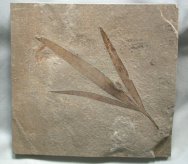Name: Sapindales;
Sapindaceae; Sapindopsis anhouryi (Soapberry family)
Division:
Magnoliophyta; Class:
Magnoliopsida; Order: Sapindales
Geological
Age: Middle Cretaceous;
Middle Cenomanian Stage (93 million years ago)
Size (25.4
mm = 1 inch): 160 mm long, 85 mm across on a 160 mm by 165 mm matrix
Fossil Site:
en-Nammoura, Lebanon Sublithographic Limestone
 Description:
Known for its incredibly well-preserved fish and crustaceans, the
sublithographic limestone of the Cretaceous of Lebanon also preserved
incredible detail here as well. This is an exceptional example of
the Sapindaeceae (soapberry tree) known as Sapindopsis, a genus
found as well in the Cretaceous deposits of western North America.
The modern-day genus Sapindus was first seen in the Eocene of North
America. Its fruits contain saponin, a substance that has been used
as a soap substitute. Few plants are preserved in the Cretaceous
marine deposits of Lebanon, and most are marine algae, so this is
a most uncommon fossil. The quarries of en-Nammoura are one of the
few places where plants of this age are preserved, and this is an
exceptional example of the type. Description:
Known for its incredibly well-preserved fish and crustaceans, the
sublithographic limestone of the Cretaceous of Lebanon also preserved
incredible detail here as well. This is an exceptional example of
the Sapindaeceae (soapberry tree) known as Sapindopsis, a genus
found as well in the Cretaceous deposits of western North America.
The modern-day genus Sapindus was first seen in the Eocene of North
America. Its fruits contain saponin, a substance that has been used
as a soap substitute. Few plants are preserved in the Cretaceous
marine deposits of Lebanon, and most are marine algae, so this is
a most uncommon fossil. The quarries of en-Nammoura are one of the
few places where plants of this age are preserved, and this is an
exceptional example of the type.
|
|




